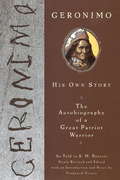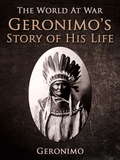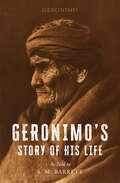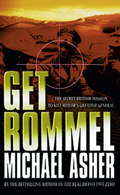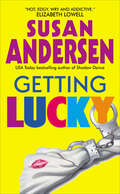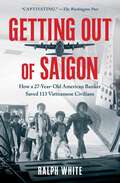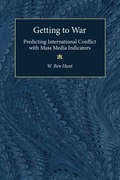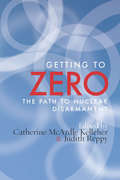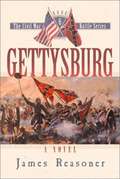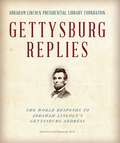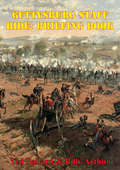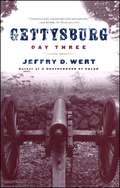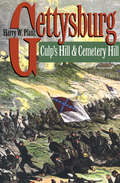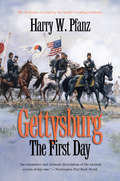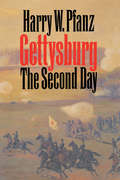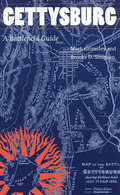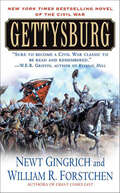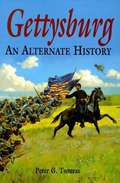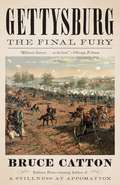- Table View
- List View
Germs: Biological Weapons and America's Secret War
by Judith Miller William Broad Stephen EngelbergAnalysis of the role of germs and biological weaponry in future wars.
Germs: Biological Weapons and America's Secret War
by Judith Miller Stephen Engelberg William J BroadIn the wake of the anthrax letters following the attacks on the World Trade Center, Americans have begun to grapple with two difficult truths: that there is no terrorist threat more horrifying -- and less understood -- than germ warfare, and that it would take very little to mount a devastating attack on American soil. In Germs, three veteran reporters draw on top sources inside and outside the U.S. government to lay bare Washington's secret strategies for combating this deadly threat. Featuring an inside look at how germ warfare has been waged throughout history and what form its future might take (and in whose hands), Germs reads like a gripping detective story told by fascinating key figures: American and Soviet medical specialists who once made germ weapons but now fight their spread, FBI agents who track Islamic radicals, the Iraqis who built Saddam Hussein's secret arsenal, spies who travel the world collecting lethal microbes, and scientists who see ominous developments on the horizon. With clear scientific explanations and harrowing insights, Germs is a masterfully written -- and timely -- work of investigative journalism.
Geronimo
by GeronimoEnter the world of Geronimo Stilton, where another funny adventure is always right around the corner. Each book is a fast-paced adventure with lively art and a unique format kids 7-10 will love. Ah, there's nothing like a relaxing vacation on the beach! I would spread out by the crystal-clear water with a good book. What more could a mouse want? At least, that was the plan. But somehow, my vacations never seem to go according to plan. Instead of a beautiful seaside resort, I found myself in a fleabag hotel that was falling down around my ears! Oh, would I ever be able to relax and enjoy my vacation??
Geronimo's Story of His Life (The World At War)
by GeronimoGeronimo's Story of His Life is the oral life history of a legendary Apache warrior. Composed in 1905, while Geronimo was being held as a U.S. prisoner of war at Fort Sill, Oklahoma.
Geronimo's Story of His Life: As Told to S. M. Barrett
by Geronimo S. M. BarrettA pivotal piece of nineteenth-century Native American history from a tireless warrior seeking justice for his people. Storied leader of the Bedonkohe band of the Chiricahua Apache tribe, Geronimo led resistance against Mexican and American troops seeking to drive the Apache from their land during the 1850s through the 1880s. In 1886, he finally surrendered to the US Army and became a prisoner of war. Although he would never return to his homeland, Geronimo became an iconic figure in Native American society and even had the honor of riding with President Theodore Roosevelt in his 1905 inaugural parade. That same year, he agreed to share his story with Stephen M. Barrett, a superintendent of education from Lawton, Oklahoma. In Geronimo&’s own words, this is his fascinating life story. Beginning with an Apache creation myth, he discusses his youth and family, the bloody conflicts between Mexico and the United States, and his two decades of life as a prisoner. Revered by his people and feared by his enemies, Geronimo narrates his memoir with a compassionate and compelling voice that still resonates today.
Get Lucky (Tall, Dark and Dangerous #9)
by Suzanne BrockmannA Navy SEAL teams up with a feisty journalist to catch a dangerous criminal in the New York Times–bestselling author’s thrilling military romance.While the men of Alpha Squad deploy on a dangerous mission, Luke “Lucky” O’Donlon stays behind for his sister’s wedding. But it turns out his elite skills are needed at home—when a serial rapist starts terrorizing San Felipe. Suspecting the culprit might be a SEAL, Lucky joins a local task force to unmask the menace. And that’s when he meets journalist Sydney Jameson . . . Sydney isn’t the typical arm candy Lucky goes for, but he’s used to women swooning at his feet. So why does this smart, no-nonsense reporter seem immune to his charms? As they work together on their dangerous assignment, Lucky is determined to turn her frosty attitude around—and make her fall head over heels for him.
Get Rommel: The secret British mission to kill Hitler's greatest general
by Michael AsherHow the first ever SAS operation ended in disaster in the desertIn summer 1941 Erwin Rommel was Hitler's favourite general: he had driven the British out of Libya and stood poised to invade Egypt. He seemed unbeatable. So the British decided to have him killed. The British opened their counter-attack with a series of special forces raids, the first ever operation by the newly formed SAS. Rommel was one of the targets.Michael Asher reveals how poor planning and incompetence in high places led to disaster in the desert-- and how fantastic bravery and brilliant improvisation enabled a handful of men to escape. Classic real life adventure, written by best-selling desert expert and novelist Michael Asher.
Getting Lucky
by Susan AndersenRoad trip!It started out as an impulsive lark for Lily Morrisette, fueled by her strong chemical reaction to sexy Zach Taylor. A tough, blustery, yet tender-in-spite-of-himself career military man, Zach's determined to break up his darling "baby sister" Glynnis's wedding engagement . . . and Lily's coming along for the ride. But there's no Glynnis waiting for them at the end of the line—only a ransom note . . . and a death threat.Amid a dangerous nest of family secrets, the heat between Zach and Lily soon becomes unbearable as a kidnapper's dark and twisted scheme pulls them closer than either dreamed possible. And when passion explodes, Lily's reckless act could prove to be either the best risk she's ever taken . . . or her last.
Getting Out of Saigon: How a 27-Year-Old Banker Saved 113 Vietnamese Civilians
by Ralph WhiteA &“captivating&” (The Washington Post) true story of &“courage, resolve, and determination&” (The Christian Science Monitor), author Ralph White&’s successful effort to save nearly the entire staff of the Saigon branch of Chase Manhattan bank and their families before the city fell to the North Vietnamese Army. In April 1975, Ralph White was asked by his boss to transfer from the Bangkok branch of the Chase Manhattan Bank to the Saigon Branch. He was tasked with closing the branch if and when it appeared that Saigon would fall to the North Vietnamese army and ensure the safety of the senior Vietnamese employees. But when he arrived, he realized the situation in Saigon was far more perilous than he had imagined. The senior staff members there urged him to evacuate the entire staff of the branch and their families, which was far more than he was authorized to do. Quickly he realized that no one would be safe when the city fell, and it was no longer a question of whether to evacuate but how. Getting Out of Saigon is an &“edge-of-your-seat&” (Oprah Daily) story of a city on the eve of destruction and the colorful characters who respond differently to impending doom. It&’s a remarkable account of one man&’s quest to save innocent lives not because he was ordered but because it was the right thing to do.
Getting to War: Predicting International Conflict with Mass Media Indicators
by W. Ben HuntThis book shows how to predict wars. More specifically, it tells us how to anticipate in a timely fashion the scope and extent of interstate conflict. By focusing on how all governments--democratic or not--seek to secure public support before undertaking risky moves such as starting a war, Getting to War provides a methodology for identifying a regime's intention to launch a conflict well in advance of the actual initiation. The goal here is the identification of leading indicators of war. Getting to War develops such a leading political indicator by a systematic examination of the ways in which governments influence domestic and international information flows. Regardless of the relative openness of the media system in question, we can accurately gauge the underlying intentions of those governments by a systematic analysis of opinion-leading articles in the mass media. This analysis allows us to predict both the likelihood of conflict and what form of conflict--military or diplomatic/economic--will occur.
Getting to Zero
by Mcardle Kelleher Catherine Reppy JudithGetting to Zero takes on the much-debated goal of nuclear zero—exploring the serious policy questions raised by nuclear disarmament and suggesting practical steps for the nuclear weapon states to take to achieve it. It documents the successes and failures of six decades of attempts to control nuclear weapons proliferation and, within this context, asks the urgent questions that world leaders, politicians, NGOs, and scholars must address in the years ahead.
Gettysburg
by John BrickTom and Will, Yankee soldiers, spend most of their convalescent leave on a rebel girl's Pennsylvania farm to help her out, instead of going on to Tom's home in New York. Both fall in love with her and plan to return to her after the war. Her brother, who is also a rebel, home from the war convalescing from a wound, turns them over to invading rebel troops when they come to the farm in order to convince them that he isn't a spy or a deserter. With some help, Will and Tom escape and are just in time for the battle of Gettysburg, which they would have missed had they only taken the last week of their leave. After fighting among The Devil's Rocks, one is killed and the other survives after spending two days lying seriously wounded on the battlefield. He writes to Susan, the rebel girl, but receives the letter back, so he begins a search for her.
Gettysburg (The Civil War Battle Series, Book #6)
by James Reasoner[From the back cover] Lower down on the slope, the cannon fire was still crashing among the trees, so they couldn't retreat. Will's brain was growing battle-numbed, but he understood that much. He and his companions could go up to death or down to death, but either way, that was all that awaited them. A huge anger began to grow inside him. They had fought so hard, so well, for so long. They had won battles they weren't supposed to win, defeating enemy forces that were larger-sometimes more than twice as large-and better armed and equipped. They had dared to hope that the justness of their cause would carry them to victory against great odds. And for a time that victory had seemed to be within their grasp. Now...now it was slipping away. One more battle, the men had said on their way up here to Pennsylvania. One more fight, one more defeat for the Yankees, and they would give up. They would see they had been wrong. It was almost over, and when it was they could all go home... One more battle. It was no high-pitched, keening Rebel yell that came from Will's throat as he threw himself up the slope once more. Instead it was a hoarse, inarticulate shout of rage. The power of that shout reached out to the men around him and drew them with him, and together they went up the hill and over the crest. Bullets fanned the air around them, but they no longer cared. In their hearts burned the bitter blaze of men who knew they were about to die. A hundred yards away thousands of Yankees crouched behind breastworks that had been erected over the past two days. The volley of fire that roared from their rifles swept the rim of the hill. The leading edge of the Confederate advance was blasted back, but as each man fell another took his place...until finally there were no more ...
Gettysburg 1863
by Carl Smith Adam HookOsprey's study of the Battle of Gettysburg (1863), one of the decisive battles of the American Civil War (1861-1865). The Confederate invasion of the Northern states was General Lee's last great gamble. By taking the war to the Union he hoped to force Lincoln into peace negotiations, or win support from the European powers who were watching events closely from across the Atlantic. Equally, Meade's Army of the Potomac needed to regain it's fighting credibility after the setbacks of Fredericksburg and saw this as an opportunity to redeem its honour. The clash of 150,000 soldiers from both sides would ultimately decide the fate of a nation.
Gettysburg Rebels: Five Native Sons Who Came Home to Fight as Confederate Soldiers
by Tom McmillanGettysburg Rebels is the gripping true story of five young men who grew up in Gettysburg, moved south to Virginia in the 1850s, joined the Confederate army - and returned "home" as foreign invaders for the great battle in July 1863. Drawing on rarely-seen documents and family histories, as well as military service records and contemporary accounts, Tom McMillan delves into the backgrounds of Wesley Culp, Henry Wentz and the three Hoffman brothers in a riveting tale of Civil War drama and intrigue.
Gettysburg Replies: The World Responds to Abraham Lincoln's Gettysburg Address
by Abraham Lincoln Presidential Library FoundationAlmost five months after the Civil War&’s deadliest clash, President Abraham Lincoln and other Union leaders gathered to dedicate the Soldiers&’ National Cemetery in Gettysburg, Pennsylvania. The program for the occasion featured music, prayer, orations, and benedictions. In the middle of it all, the president gave a few commemorative remarks, speaking for just two minutes, delivering what we now know as the Gettysburg Address. Challenged to mark the enormity of the battle—which had turned the tide of the war, though neither side realized it yet—Lincoln used 272 words in ten sentences to rededicate the Union to the preservation of freedom. It remains the most important statement of our nation&’s commitment to personal liberty since the Revolutionary War and has become one of the most important speeches in American history, a cornerstone of who we are as a country. A century and a half later, we still hold Lincoln&’s message in our hearts. For Gettysburg Replies, the Abraham Lincoln Presidential Library and Museum challenged presidents, judges, historians, filmmakers, poets, actors, and others to craft 272 words of their own to celebrate Lincoln, the Gettysburg Address, or a related topic that stirs their passions. President Jimmy Carter reveals how the Gettysburg Address helped bring Egypt and Israel closer at the Camp David Peace Accords. Supreme Court Justice Sandra Day O&’Connor reflects on Lincoln&’s dedication to the importance of civic education. General Colin Powell explains how Martin Luther King Jr. took up Lincoln&’s mantle and carried it forward. Filmmaker Steven Spielberg touches on the benefits and perils of hero worship. Poet Laureate Billy Collins explores the dichotomy between the private man who wrote poetry (&“My Childhood Home I See Again&”) and the president who stood before all. Attorney Alan Dershowitz echoes Lincoln&’s words to rally us to the freedom from weapons of mass destruction. Gettysburg Replies features images of important Lincoln documents and artifacts, including the first copy of the address that Lincoln wrote out after delivering it, the program from the cemetery dedication, Lincoln&’s presidential seal, and more. Together, these words and images create a lasting tribute not only to Lincoln himself but also the power of his devotion to freedom.
Gettysburg Staff Ride: Briefing Book [Illustrated Edition]
by Ted Ballard Billy ArthurContains more than 20 maps, diagrams and illustrationsIf neither General Meade nor General Lee planned to fight at Gettysburg, how did it happen that the first three days of July 1863 were to become arguably the most important span in the Civil War? That question cannot be fully answered without viewing McPherson's Ridge or Oak Hill, nor can one really understand the urgency of Chamberlain's bayonet charge nor the audacity of Pickett's division at the Angle without visiting those places.Accordingly, the purpose of a Gettysburg staff ride is to visit these and other locations on the battlefield and analyze the battle through the eyes of the men who were there, both leaders and rank and file soldiers. Hopefully, by understanding the actions, inactions and reactions of commanders and their troops in real situations we may gain insights into the human condition under stress and decision making during combat.
Gettysburg, Day Three
by Jeffry D. WertJeffry D. Wert re-creates the last day of the bloody Battle of Gettysburg in astonishing detail, taking readers from Meade's council of war to the seven-hour struggle for Culp's Hill -- the most sustained combat of the entire engagement. Drawing on hundreds of sources, including more than 400 manuscript collections, he offers brief excerpts from the letters and diaries of soldiers. He also introduces heroes on both sides of the conflict -- among them General George Greene, the oldest general on the battlefield, who led the Union troops at Culp's Hill.A gripping narrative written in a fresh and lively style, Gettysburg, Day Three is an unforgettable rendering of an immortal day in our country's history.
Gettysburg--Culp's Hill and Cemetery Hill
by Harry W. PfanzIn this companion to his celebrated earlier book, Gettysburg--The Second Day, Harry Pfanz provides the first definitive account of the fighting between the Army of the Potomac and Robert E. Lee's Army of Northern Virginia at Cemetery Hill and Culp's Hill--two of the most critical engagements fought at Gettysburg on 2 and 3 July 1863. Pfanz provides detailed tactical accounts of each stage of the contest and explores the interactions between--and decisions made by--generals on both sides. In particular, he illuminates Confederate lieutenant general Richard S. Ewell's controversial decision not to attack Cemetery Hill after the initial southern victory on 1 July. Pfanz also explores other salient features of the fighting, including the Confederate occupation of the town of Gettysburg, the skirmishing in the south end of town and in front of the hills, the use of breastworks on Culp's Hill, and the small but decisive fight between Union cavalry and the Stonewall Brigade."Rich with astute judgments about officers on each side, clearly written, and graced with excellent maps, Pfanz's book is tactical history at its finest.--Civil War "A meticulous examination of the desperate engagements that over the course of the three days swept up and down the rough slopes of these two hills, the strategic anchors of the Union right flank.--New York Times Book Review"The first and most comprehensive narrative yet written on this part of the battlefield. . . . Civil War enthusiasts should clear a space on their bookshelf for Gettysburg--Culp's Hill and Cemetery Hill.--Blue and Gray Harry Pfanz provides the definitive account of the fighting between the Army of the Potomac and Robert E. Lee's Army of Northern Virginia at Cemetery Hill and Culp's Hill--two of the most critical engagements fought at Gettysburg on 2 and 3 July 1863. He provides detailed tactical accounts of each stage of the contest and explores the interactions between--and decisions made by--generals on both sides. In particular, he illuminates Confederate lieutenant general Richard S. Ewell's controversial decision not to attack Cemetery Hill after the initial Southern victory on 1 July. -->
Gettysburg--The First Day
by Harry W. PfanzFor good reason, the second and third days of the Battle of Gettysburg have received the lion's share of attention from historians. With this book, however, the critical first day's fighting finally receives its due. After sketching the background of the Gettysburg campaign and recounting the events immediately preceding the battle, Harry Pfanz offers a detailed tactical description of events of the first day. He describes the engagements in McPherson Woods, at the Railroad Cuts, on Oak Ridge, on Seminary Ridge, and at Blocher's Knoll, as well as the retreat of Union forces through Gettysburg and the Federal rally on Cemetery Hill. Throughout, he draws on deep research in published and archival sources to challenge many long-held assumptions about the battle.
Gettysburg--The Second Day
by Harry W. PfanzThe second day's fighting at Gettysburg--the assault of the Army of Northern Virginia against the Army of the Potomac on 2 July 1863--was probably the critical engagement of that decisive battle and, therefore, among the most significant actions of the Civil War. Harry Pfanz, a former historian at Gettysburg National Military Park, has written a definitive account of the second day's brutal combat. He begins by introducing the men and units that were to do battle, analyzing the strategic intentions of Lee and Meade as commanders of the opposing armies, and describing the concentration of forces in the area around Gettysburg. He then examines the development of tactical plans and the deployment of troops for the approaching battle. But the emphasis is on the fighting itself. Pfanz provides a thorough account of the Confederates' smashing assaults -- at Devil's Den and Litle Round Top, through the Wheatfield and the Peach Orchard, and against the Union center at Cemetery Ridge. He also details the Union defense that eventually succeeded in beating back these assaults, depriving Lee's gallant army of victory.Pfanz analyzes decisions and events that have sparked debate for more than a century. In particular he discusses factors underlying the Meade-Sickles controversy and the questions about Longstreet's delay in attacking the Union left. The narrative is also enhanced by thirteen superb maps, more than eighty illustrations, brief portraits of the leading commanders, and observations on artillery, weapons, and tactics that will be of help even to knowledgeable readers. Gettysburg--The Second Day is certain to become a Civil War classic. What makes the work so authoritative is Pfanz' mastery of the Gettysburg literature and his unparalleled knowledge of the ground on which the fighting occurred. His sources include the Official Records, regimental histories and personal reminiscences from soldiers North and South, personal papers and diaries, newspaper files, and last -- but assuredly not least -- the Gettysburg battlefield. Pfanz's career in the National Park Service included a ten-year assignment as a park historian at Gettysburg. Without doubt, he knows the terrain of the battle as well as he knows the battle itself.
Gettysburg: A Battlefield Guide (This Hallowed Ground: Guides to Civil War Battlefields)
by Brooks D. Simpson Mark GrimsleyLittle Round Top, the Railroad Cut, Pickett’s Charge—these are the turning points within the most important battle of the Civil War. Even careful students of Gettysburg, however, can find themselves disoriented when visiting the site itself. Here, finally, is a convenient guide for serious student and casual visitor alike that makes plain the sweep of events and the geography of the battlefield. This invaluable guidebook was created by scholars who have walked the battlegrounds, consulted with local experts and park guides, and studied the testimony left behind by the participants. Gettysburg will help you find all the important locales and understand what the participants saw in 1863, even if you have no prior knowledge of the battle. Designed to enhance the experience of both first-time and returning visitors, this guide can be used alone or as a supplement to a tour. Clearly written and illustrated with maps and photographs, this is the book to have when you explore Gettysburg.
Gettysburg: A Novel of the Civil War (The Gettysburg Trilogy #1)
by Newt Gingrich William R. ForstchenThe New York Times–bestselling Civil War novel: a “well-executed alternative history [that] imagines a Confederate victory at Gettysburg” (Publishes Weekly).An action-packed and painstakingly researched novel by former Speaker of the House Newt Gingrich and historical fiction author William R. Forstchen, Gettysburg stands as the first book in a series to tell the story of how a victory for Confederate General Robert E. Lee would have changed the destiny of the nation forever.The year is 1863, and General Lee and his Army of Northern Virginia are poised to attack the North. Launching his men into a sweeping operation, Lee audaciously pursues his last best chance for ultimate victory. With renewed spirit, Lee’s lieutenants embark on the Gettysburg Campaign that many dream “should have been.”The soldiers in the line, Yank and Reb, knew as well that this would be the great challenge, the decisive moment that would decide whether a nation would die, or be created. Both sides were ready, willing to lay down their lives for their Cause.
Gettysburg: An Alternative History
by Peter G. TsourasThe author has written an account of the Battle of Gettysburg as though some of the "What Ifs" had hapened. What if J.E.B. Stewart had arrived in time to be in the second day's fighting?, et. cet.
Gettysburg: The Final Fury (Vintage Civil War Library)
by Bruce CattonThis classic work by Pulitzer Prize winner Bruce Catton, one of the great historians of the Civil War, takes an incisive look at the turning point of the war, when the great armies of the North and South came to Gettysburg in July 1863. Engaging and authoritative, Catton analyzes the course of events at Gettysburg, clarifying its causes and bringing to life the most famous battle ever fought on American soil. Paying full heed to the human tragedies that occurred, Gettysburg: The Final Fury gives an hour-by-hour account of the three-day battle, from the skirmish that began the engagement, to Pickett's ill-fated charge. Catton provides context for the fateful decisions made by each army's commanders, and examines the battle's military and political consequences, placing it within the larger narrative of the Civil War and American history.


